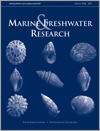Marine and Freshwater Research
Volume 70
Number 2 2019
In this study, villagers living near the Nam Kading River in central Lao PDR were trained to record fisheries harvest data at fisher landing sites in four villages. At least 93 fish species from 65 genera were documented in the river fishery, with differences in the fish assemblage observed among villages, representing the first scientific characterisation of this highly diverse fishery.
Knowledge of the biodiversity impacts of hydropower design on the Lancang River is essential to inform different stakeholders along the Mekong River. In this paper we conducted interdisciplinary research that systemically assessed the effects by integrating the knowledge of engineering, biology, policies and environmental management. Significantly, an overview of the biodiversity effects of hydropower design on the Lancang River is provided, and differences in the effectiveness of proposed conservation measures between the lower and upper Lancang Basins are identified.
The succession observed in all lakes must cause directional changes in the fauna inhabiting them. This paper reports the results of an analysis of aquatic beetles, based on samples collected from 40 lakes in north Poland. A detailed understanding of the changes in these assemblages makes it possible to better learn the causes and mechanisms of changes in lakes so they can be managed more sustainably.
The aim of this study was to analyse the post-drought recolonisation process of diatom communities that differed in terms of taxonomic composition and percentage of endangered taxa, exploring the possible development of resistance mechanisms. Highly natural stretches with a high abundance of endangered species were less resilient to drought than assemblages composed of general and widespread taxa. Moreover, resistance mechanisms did not play a significant role in the recovery process.
This paper outlines the use of the hydrogeological landscape framework as the basis of an assessment of climate change vulnerability for wetlands across the Australian Capital Territory. The assessment identifies the water balance equation, level of current anthropogenic pressure and future hydrological and ecological changes of individual wetlands, with statistical cluster analysis to rank and identify similarity in vulnerability. The paper also discusses aspects required for an associated management module for prioritisation and decision support.
Seagrasses provide important ecosystem services, including the uptake and storage of carbon. In Guam, biomass of the sagrass Enhalus acoroides is the highest reported for this species and among the highest for all seagrass species. However, between 2004 and 2015, seagrass meadows in Guam decreased by 22%, although it was is unclear whether this change was caused by natural or human factors.
Three freshwater mussel species from the Hunter Valley, Australia, namely Alathyria profuga, Cucumerunio novaehollandiae and Hyridella drapeta, were studied to identify their potential as new environmental proxy archives from Australian freshwater bodies. The oxygen isotope ratio and high-resolution trace element concentrations suggest that A. profuga has good potential as an environmental proxy archive, whereas C. novaehollandiae and H. drapeta are probably not suitable for palaeoclimatic studies.
This study identified patterns of invertebrate biodiversity on limestone and granite intertidal reefs within Ngari Capes Marine Park, south-west Western Australia. Geology was a significant indicator of variation in percentage cover of substrate and invertebrate composition, which covaried with structural and habitat complexity. These findings emphasise the need for management programs to accommodate different habitat types to effectively conserve biodiversity.
We investigated the effect of algal morphology on the structure of gastropod communities that use the canopies of Hormosira banksii as habitat. The abundance and diversity of gastropod species varied among the different seaweed morphologies, highlighting a positive effect of thallus length and vesicle size on the number of gastropod species associated with the seaweed.
Culcita schmideliana cushion starfish were identified on a reef system in the Maldives at a high densities, exceeding abundances previously reported from other Indo-Pacific locations. The starfish showed a feeding preference for juvenile colonies of Acropora and Pocillopora. These two corals were formerly dominant on these reefs, but populations collapsed during the 2016 bleaching event. The recovery of these corals is likely to be delayed or prevented due to the high levels of predation associated with an abnormally high abundance of C. schmideliana.
For the first time, multiple tiger, bull and nurse sharks were all recorded feeding on the same sperm whale carcass. Moreover, the event was observed using a drone, meaning that the sharks were undisturbed by humans and exhibited natural behaviour. Contrary to expectation, there was no aggression between any of the sharks. Instead, they all fed calmly alongside each other during this communal scavenging event.





